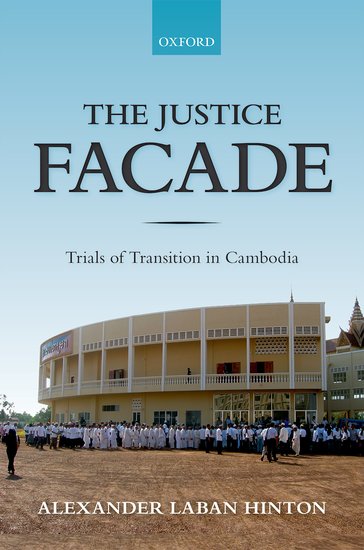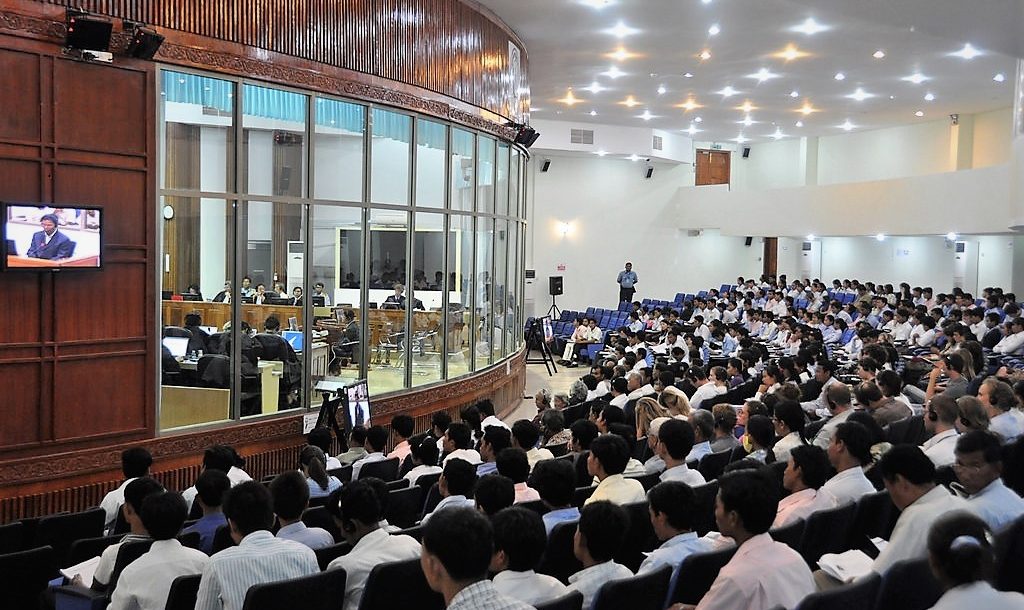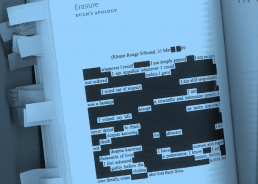 Since 2006, the Extraordinary Chambers in the Courts of Cambodia (ECCC) have prosecuted international crimes committed between 17 April 1975 and 7 January 1979. In those years of Democratic Kampuchea, the Khmer Rouge regime caused perhaps a quarter of Cambodia’s population to die through starvation, forced labour, torture and killings. An innovative “hybrid” tribunal with both Cambodian and international staff and procedures, the ECCC represents the key transformational mechanism to secure justice for these atrocities, leading Cambodia from its violent past toward a prosperous, rule-of-law-abiding democratic future.
Since 2006, the Extraordinary Chambers in the Courts of Cambodia (ECCC) have prosecuted international crimes committed between 17 April 1975 and 7 January 1979. In those years of Democratic Kampuchea, the Khmer Rouge regime caused perhaps a quarter of Cambodia’s population to die through starvation, forced labour, torture and killings. An innovative “hybrid” tribunal with both Cambodian and international staff and procedures, the ECCC represents the key transformational mechanism to secure justice for these atrocities, leading Cambodia from its violent past toward a prosperous, rule-of-law-abiding democratic future.
Or so the story goes.
Alexander Laban Hinton holds up a mirror to this aspiration for “justice” and invites the reader to jump through, and find not one, but innumerable reflections of what transitional justice means—for different people, and in different times and spaces. He counters the idea that international crimes tribunals deliver a “better future” through prosecuting crimes, leading from a time and place of violence and authoritarianism toward reconciliation and stability, delivered by a liberal democratic state. Instead, he calls this idea of transitional justice “imaginary”, a “facade” that leaves out crucial matters—including the impact of power, geopolitics, and individual experiences.
Drawing on critical transitional justice scholarship and anthropological expertise derived from extensive research in Cambodia over many years, Hinton reveals what legal justice masks: a complex, turbulent, “dark world” of multiple possibilities. Here, there is not just one point to transitional justice, but the potential for numerous, shifting perceptions and translations. Rather than a single “justice cascade” from point A to point B, there are—to use the analogy developed throughout the book—dynamic ‘”ecosystems” filled with eddies, whirlpools, turbulence, counter-current, still spots, and vortices’ (p24).
If all of this complexity seems, well, complex, the structure of the book helps to navigate these waters. (Even if the idea is not to get to one particular place, but to appreciate the ever-changing nature and effects of transitional justice initiatives.) A preface describes the plot of a booklet used by a Cambodian NGO to explain the ECCC to Cambodians. Using a comic strip format, the booklet describes how “Uncle Yan”, who seems traumatised by his experiences during Democratic Kampuchea, comes to learn about the ECCC and participate in its proceedings, thereby finding peace. This, he imagines, involves a prosperous Cambodia—as depicted by electricity and smoking factory stacks in the distance. This story is returned to throughout the book to illustrate the typical A-to-B depiction of the aims and outcomes of transitional justice, as well as how that message has been translated in the Cambodian context.
The book’s introduction then helpfully explains the numerous complicated terms adopted throughout the book. These include the temporal and spatial aspects of the “imaginary”, the “point” and “justice facade”, and ideas such as “universalism”, “globalism” and “localization”. There is also a proposal for what might still be productive about this “assemblage” of ideas concerning transitional justice: the potential that new possibilities might emerge when actors engage with transitional justice concepts and institutions. Hinton’s suggestion that encounters between different perspectives can create unexpected consequences is inspired by Anna Tsing’s concept of friction, but Hinton terms it “combustion”. This sounds like a more enthusiastic term, but is supposed to indicate that contacts with transitional justice can also “smolder, fizzle, or fail to ignite” (p28). In the introduction Hinton also explains his “discursively-informed” phenomenological approach, which (loosely) involves being aware of how discourse and power mediate lived experiences and contexts. Subsequent chapters then elaborate upon aspects of the transitional justice imaginary by analysing past NGO activities and documents, individual experiences before, during and following Democratic Kampuchea, and outreach processes associated with the ECCC’s operations.
For instance, chapter 1 considers the effects of the ECCC’s narrow jurisdiction over a small window of time (the several years of Democratic Kampuchea). This both diminishes events prior to and subsequent to the regime—and international responsibility for those events—but also produces a narrative in which a backward, authoritarian, violent past will be transformed in a progressive manner toward a liberal future. That narrative is not only factually highly questionable in Cambodia, but also leaves out important parts of many other stories, which the book then reveals.
The remaining chapters detail the individual experiences of ECCC and NGO outreach workers and “civil parties” (victims who participate in the ECCC trials). These not only make fascinating reading, but demonstrate that many aspects of life before and after Democratic Kampuchea do not fit standard understandings of transitional justice. These include the significance of religion (particularly Buddhist teachings and traditional spiritual beliefs and practices), family and social relationships, living and studying outside Cambodia, and the various ways that language can be translated. Rather than simply providing material to secure prosecutions and a “transition”, these aspects can be central to individual understandings of justice, even if they appear removed from the judicial process. Hinton demonstrates how hints of these undercurrents emerged during the ECCC trials. Often these may have gone unnoticed—perhaps evident only in an awkwardly translated Cambodian phrase or Buddhist notion—while at other times the ruptures were more obvious, as when civil parties publicly lambasted the ECCC in the media.
They all, Hinton argues, demonstrate several features of the transitional justice facade. First, the idea that transitional justice proceeds in one linear direction over time. Second, that there are clear spatial boundaries between “global” and “local”, whereas there are “multiple points of contact that ‘combust’ in different and often unpredictable ways” (p27). Third, the technical (legal) disciplines associated with transitional justice, which represent particular forms of power and knowledge. Fourth, the normative truth claims and assumptions the “facade” presents, which may diverge from alternative understandings. Fifth, its performative, subjective and aesthetic aspects, which assert a particular script, roles, and a “look” for the delivery of transitional justice, whereas there may be other possibilities. Finally, the idea that there are different “dispositions” toward justice linked to certain categories of people and ideas. The title of each chapter indicates which of these critiques it is meant to address, although they all contribute toward Hinton’s general argument against a progressive linear understanding of transitional justice.In adopting this structure, which draws out individual stories, Hinton not only advocates for a new approach to examining experiences of transitional justice beyond judicial processes—he implements it. To be sure, there has already been significant critique of the “justice cascade” and the transitional justice “imaginary” Hinton describes, including by some of the “local turn” and critical scholars he references such as Kamari Clarke. Some have identified some of the temporal and spatial dimensions Hinton refers to (and the book could have elaborated upon the theoretical relationship between these two aspects). The ECCC has itself attracted significant criticism. As Hinton notes, this is usually directed toward allegations of corruption, political interference, use of time and resources, or fair trial concerns, than for the more fundamental type of concerns raised by Hinton, although examples exist.
Where Hinton’s work really stands apart, though, is in its phenomenological approach that “reorients attention to what is masked by the justice facade” (p23). The result is a book filled with the fascinating stories one might hear in conversations with Cambodians, or with court and NGO staff in Cambodia, or derive from some exhibitions—but does not frequently find in transitional justice (especially international criminal law) scholarship. The book also offers another space to respectfully share diverse individual experiences that may have been minimised by the trial process.
This alone makes the book worth reading. However, Hinton’s ability to not only critique the standard narrative of transitional justice, but to offer and implement an alternative approach is also impressive—and useful. The Justice Facade extends well beyond a simplistic condemnation of the ECCC as a neo-colonial artifice, by identifying the multiple unexpected and creative initiatives that transitional justice processes may stimulate (“combust”).
This method and argument contributes to transitional justice—and particularly international criminal justice—scholarship and has implications for human rights, peacebuilding, and development studies in Cambodia. The Justice Facade is also compelling reading, with Hinton’s attention toward lived experience offering a richly emotive and personalised account of the dynamic impact of the Democratic Kampuchea period.
 Facebook
Facebook  Twitter
Twitter  Soundcloud
Soundcloud  Youtube
Youtube  Rss
Rss 

 Dr Emma Palmer is a Lecturer at Griffith Law School. Her thesis, International Criminal Law in Southeast Asia: Beyond the International Criminal Court, was completed at UNSW, Australia, in 2017. You can follow her on Twitter at
Dr Emma Palmer is a Lecturer at Griffith Law School. Her thesis, International Criminal Law in Southeast Asia: Beyond the International Criminal Court, was completed at UNSW, Australia, in 2017. You can follow her on Twitter at